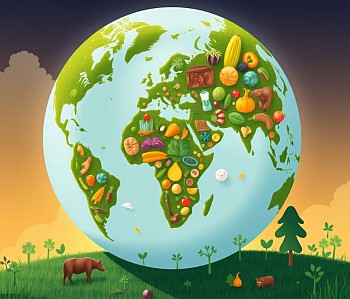nCa-AI Collaborative Report
There is profound and tangible connection between food security and peace. The relationship is bidirectional: food insecurity can lead to conflict, and conflict exacerbates food insecurity. At the same time, peace creates the conditions necessary for sustainable food production and distribution. Let’s explore this connection in detail and examine how peace can bolster food security.
The Link between Food Security and Peace
Food Insecurity as a Driver of Conflict
- Resource Scarcity: When food is scarce, competition for resources like land, water, and crops can escalate into violence. For example, the Darfur conflict in Sudan was partly fueled by competition over arable land and water.
- Economic Instability: Food price spikes can lead to social unrest, as seen during the 2007-2008 global food crisis, which triggered protests and riots in over 40 countries.
- Migration and Displacement: Food insecurity often forces people to migrate, which can strain resources in host regions and create tensions between communities.
Conflict as a Driver of Food Insecurity
- Disruption of Agriculture: Wars destroy farmland, livestock, and infrastructure, making it difficult to produce or transport food. For example, the ongoing conflict in Yemen has devastated its agricultural sector.
- Displacement of Farmers: Conflict forces farmers to flee their lands, leading to abandoned fields and reduced food production.
- Blockades and Sieges: In conflict zones, food supplies are often weaponized, with blockades preventing food from reaching vulnerable populations (e.g., Syria, Gaza).
- Economic Collapse: Wars disrupt economies, making it harder for people to afford food even when it is available.
How Peace Bolsters Food Security
Peace creates the stability necessary for sustainable food systems to thrive. Here’s how:
Stable Agricultural Production
- In peaceful conditions, farmers can cultivate crops without fear of violence or displacement.
- Investments in agriculture, such as irrigation systems and improved seeds, become more feasible.
Efficient Food Distribution
- Peaceful regions have functioning infrastructure (roads, ports, markets) that enable the efficient movement of food from producers to consumers.
- Trade agreements and cross-border cooperation flourish, ensuring food can be imported and exported as needed.
Economic Growth and Poverty Reduction
- Peace fosters economic development, which increases household incomes and makes food more affordable.
- Governments in stable regions can allocate resources to social safety nets, such as food subsidies and school feeding programs.
Investment in Innovation
- Peaceful societies are better positioned to invest in agricultural research and technology, such as drought-resistant crops and precision farming.
- Collaboration between nations can lead to breakthroughs in food production and sustainability.
Environmental Stewardship
- Peace allows for long-term planning and sustainable management of natural resources, such as forests, water, and soil.
- Communities can focus on climate adaptation strategies, such as reforestation and water conservation.
Case Studies
Post-Conflict Recovery in Rwanda
After the 1994 genocide, Rwanda focused on rebuilding its agricultural sector and promoting peace. Today, it is one of the few African countries on track to meet the UN’s Sustainable Development Goal of ending hunger.
Colombia’s Peace Agreement
The 2016 peace agreement between the Colombian government and FARC rebels included provisions for rural development and land reform, which have improved food security in previously conflict-affected areas.
The Role of Peace in Ethiopia
The recent peace agreement in the Tigray region has allowed humanitarian aid to reach millions of people facing famine, highlighting how peace can directly address food insecurity.
Challenges to Achieving Peace and Food Security
While peace is a critical enabler of food security, achieving it is not easy. Challenges include:
- Political Will: Resolving conflicts requires compromise and cooperation, which are often lacking.
- Resource Distribution: Inequitable access to resources can reignite tensions even after peace agreements.
- Climate Change: Environmental stressors can undermine both peace and food security, creating a vicious cycle.
The Way Forward
To strengthen the connection between peace and food security, the following steps are essential:
- Conflict Prevention: Address the root causes of conflict, such as inequality, resource scarcity, and political exclusion.
- Humanitarian Aid: Provide immediate food assistance to conflict-affected regions while working toward long-term solutions.
- Peacebuilding Through Agriculture: Use agriculture as a tool for reconciliation by promoting cooperative farming and resource sharing.
- Global Cooperation: Strengthen international institutions to mediate conflicts and support food security initiatives.
- Climate Action: Mitigate climate change to reduce its impact on both peace and food security.
Conclusion
The connection between food security and peace is undeniable. Food insecurity can destabilize societies and ignite conflict, while peace creates the conditions necessary for sustainable food systems. By addressing the root causes of conflict and investing in agriculture, we can break the cycle of hunger and violence. A peaceful world is not only a moral imperative but also a practical necessity for ensuring that everyone has enough to eat.
Recommendations
- Governments and international organizations should integrate food security into peacebuilding efforts.
- Humanitarian aid should focus on both immediate relief and long-term agricultural development.
- Global leaders must prioritize climate action to prevent environmental stressors from undermining peace and food security.
By fostering peace and addressing food insecurity simultaneously, we can create a world where everyone has access to sufficient, nutritious food, and where stability and prosperity prevail. /// nCa-AI collaborative, 13 February 2025 [Image credit – Flux.1-schnell]
